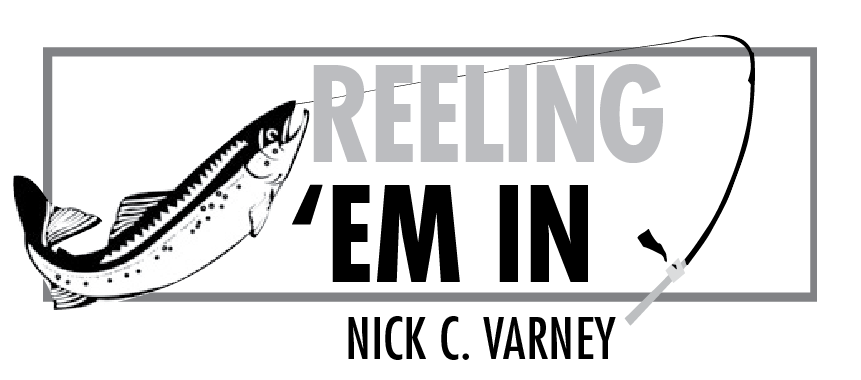Well that was a pretty wild weekend. High tides, high winds, a dash of termination dust and snagging opened at the Nick Dudiak Lagoon.
Surfers off Bishop’s Beach were riding what looked to be walled up waves while other high cresting lips spread debris along the Homer Spit Road.
At the Anchor, coho flaunted wicked attitudes when the glimmer of dawn suffused the river’s flow with a gossamer patina of silver.
The frenzied bite dimmed as the first light brightened.
A Friday check at the Spit’s cleaning tables found a few private boaters busy filleting halibut small enough to serve as coasters to a few flats that would have probably hit 20 pounds with a sizable rock stuffed into their nether regions.
Several of the fishermen grumped that, at times, they had silvers jumping near their craft but didn’t have gear onboard to take a shot at them.
Here’s a suggestion that has worked pretty well for a lot of anglers.
First, if you are on the hook or the drift, beware of the sea around you. Usually it’s not too hard to see the critters coming. They are about as stealthy as rocket launcher projectiles as they motor through the area.
So, if you are kicked back in a bottom mooch mode trying to lure a halibut and spot fish high flipping toward your yacht, pull the lines up to between 40 and 20 feet below the surface. Then start sweeping the rod upward in long arcs from the water level to above your head. The peripatetic silvers will often attack your bait if its herring parts are smaller than a Beluga.
You’ll have a fair shot even with circle hooks if you let them grab the bait and run for awhile.
We’ve only tried this approach when the tides weren’t rippin’ and we had to use old engine blocks to reach bottom.
Of course a better methodology is to have salmon gear aboard and switch to them when the soaring fish approach.
Light tackle is sufficient for these surface feeders but don’t forget to pull in your halibut lines unless you enjoy some psychotic coho going all NASCAR on the submerged ’but gear.
When casting into a rowdy school of coho, use light or medium-weight spinning tackle. Ten to twelve-pound test line will work great if it isn’t older than you. Attaching a lure of some kind to it works even better.
Now let’s take a look at this week’s fishing report.
Regulation Reminders
New: The flowing waters of the Anchor River, Ninilchik River, Deep Creek and Stariski Creek are restricted to one unbaited, single-hook from Sept. through Oct. 31.
Areas upstream of the two-mile regulatory markers on the Anchor and Ninilchik Rivers along with Deep and Stariski Creeks will remain open until Oct. 31 to fishing for dollies and steelhead/rainbow trout.
Do not besiege nor harvest salmon upstream of the two-mile regulatory markers. Claiming that you are a clueless jackanapes and lost won’t cut it.
Again, make sure that you can tell the difference between silvers and steelheads. It could be pocket painful if you can’t.
Saltwater Fisheries: Halibut
Halibut fishing continues on a slower roll and will continue to do so throughout the fall and into the winter but there’s still nice fish available even though the larger halibut have begun their migration offshore and the winds have been a bit nasty lately.
White jigs with red eyes are working pretty well along with the good old standby, herring on circle hook with a side of octopus.
Sampled fish harvested out of the Homer port averaged 11.9 pounds, with a range of 4.25 to 48.8 pounds.
Saltwater Fisheries: Salmon
Our good buddies, the feeder kings, will be available year round in Kachemak Bay and, at the moment, trolling for them and coho has been described as decent from the Silver Ridge area and near Bluff Point.
Fishing for coho at the Nick Dudiak Fishing Lagoon has slowed to a wet clay crawl but the big tides are still bringing in a few brights for the discerning snagger.
Your best bet is hitting the pond during the incoming and outgoing tides for a stab at the straggling newbies.
Other Saltwater Fishing
Fishermen are still reporting irritating run-ins with spiny dogfish.
These scaly curs usually cruise in large packs around Cook Inlet and Kachemak Bay during August, so maybe the bait stealing scourge will wane soon.
Meanwhile if you find yourself surrounded by an unruly gang of them, drag up and high step it out of there.
Lingcod fishing has been more tempered as the fall storms begin to move in. Lingcod season remains open through Dec. 31.
Nick can be reached at ncvarney@gmail.com if you have any tips, tales, or last minute yarns that you like to try and get by our censors.



